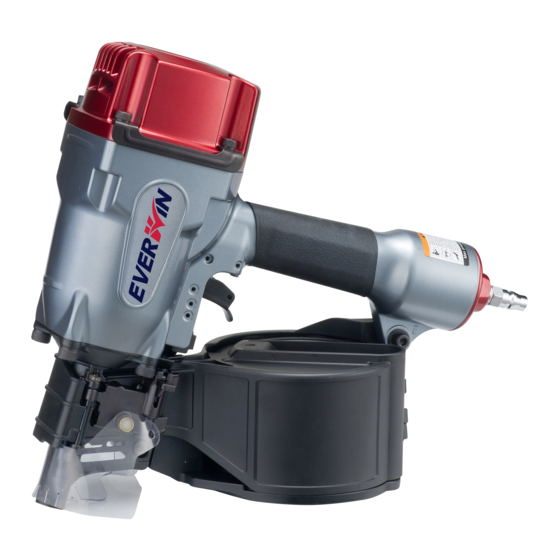
Table of Contents
Advertisement
Quick Links
PN65 / PN70 / PN80
Pneumatic Coil Nailer
OPERATIONS and MAINTENANCE MANUAL
CE DECLARATION OF CONFORMITY
BEFORE OPERATING THIS TOOL, ALL OPERATORS SHOULD READ AND STUDY
THIS MANUAL TO UNDERSTAND AND FOLLOW THE SAFETY WARNINGS AND
INSTRUCTIONS. KEEP THESE INSTRUCTIONS WITH THE TOOL FOR FUTURE
REFERENCE.
Everwin Pneumatic Corp.
19'/3/19
Advertisement
Table of Contents

Summarization of Contents
1-Year Limited Warranty
Warranty Exclusions
Lists parts and conditions not covered by the warranty, including normal wear parts, neglect, misuse, and improper maintenance.
Grounds for Industrial / Production Tool Coverage
Details coverage for high production industrial tools, limited to 90 days, and requirements for reporting defects.
CE Declaration of Conformity
English Declaration
EVERWIN PNEUMATIC CORP. declares product conformity with Machinery Directive 2006/42/EC and EN 792-13.
Safety Instructions
Eye Protection
Mandatory eye protection conforming to ANSI/CE specifications for protection against flying particles.
Air Supply and Connections
Warnings regarding air supply sources, pressure limits, and connection fittings to prevent injury.
Nail Loading Safety
Precautions during nail loading, including avoiding the discharge area and not pulling the trigger.
General Operation Safety
Guidelines for safe tool handling, trigger use, and keeping body parts away from the discharge area.
Tool Maintenance Safety
Emphasis on extra care during maintenance and following manual warnings.
Tool Specifications
Fastener Specifications
Details nail length, shank diameter, head diameter, shank type, and collation for PN65, PN70, and PN80 models.
Tool Air Fitting
Specifies the 1/4"-18 N.P.T. male plug and required inside diameter for the air fitting.
Operating Pressure
Recommended operating pressure range of 70 to 120 psi for optimal fastener performance.
Technical Data
Air Consumption
Provides air consumption rates (cfm/liter/sec) for PN65, PN70, and PN80 tools at 90 psi.
Noise Levels
Details A-weighted sound power (LWA) and sound pressure (LpA) levels for each tool model.
Operation Modes
Contact Trip Operation
Describes operation where contact with the work actuates the trip, allowing rapid fastener placement.
Sequential Trip Operation
Requires contact with work before trigger pull for precise fastener placement, preventing accidental firing.
Remote Fire Operation
Operation mode activated by a remote valve (RCVA1) for mounted machines.
Directional Exhaust Deflector
Instructions for adjusting the exhaust deflector direction on PN80 Series tools.
Air Supply and Connections
Fittings
Guidance on installing free-flowing male plugs that release air pressure when disconnected.
Hoses
Recommendations for air hose working pressure rating and fitting type for quick disconnection.
Supply Source
Emphasizes using only clean, regulated compressed air and warns against oxygen or combustible gases.
Regulator
Requirement for a 0-125 p.s.i. regulator to control operating pressure safely.
Operating Pressure
Warning against exceeding recommended operating pressure to prevent tool wear and maintain driving power.
Filter
Importance of using and maintaining an air supply filter for optimal performance and minimum wear.
Nail Loading
Prevent Accidental Injuries
Key safety points for preventing injuries during nail loading, including trigger and hand placement.
Loading the Tool
Step-by-step instructions for opening the magazine and loading nails.
Nail Length Adjustment
Guidance on adjusting the nail support to four settings for different nail lengths.
Tool Operation
Contact Trip Operation Methods
Details two methods: single fastener placement and rapid fastener operation for contact trip tools.
Sequential Trip Operation
Explains how to operate sequential trip tools by positioning the contact trip before pulling the trigger.
Remote Fire
Briefly describes the cycle mechanism for remote fire models.
Tool Operation Check
Contact Trip Operation Check
Tests to verify correct cycling behavior of the contact trip mechanism.
Sequential Trip Operation Check
Tests to ensure proper functioning of the sequential trip trigger and contact mechanism.
Safe Operation Guidelines
Additional warnings for safe use, including proper application, handling, and maintenance.
Maintaining the Pneumatic Tool
Replacement Parts
Guidance on using genuine parts and ensuring all screws are tight.
Assembly Procedure for Seals
Instructions for lubricating and assembling internal parts and O-rings.
Air Pressure and Volume
Explanation of how inadequate air flow affects tool performance and troubleshooting steps.
Driver Maintenance Instructions
Driver Length Adjustment
Information on adjusting driver length to compensate for wear and standard measurements.
















Need help?
Do you have a question about the PN70 and is the answer not in the manual?
Questions and answers